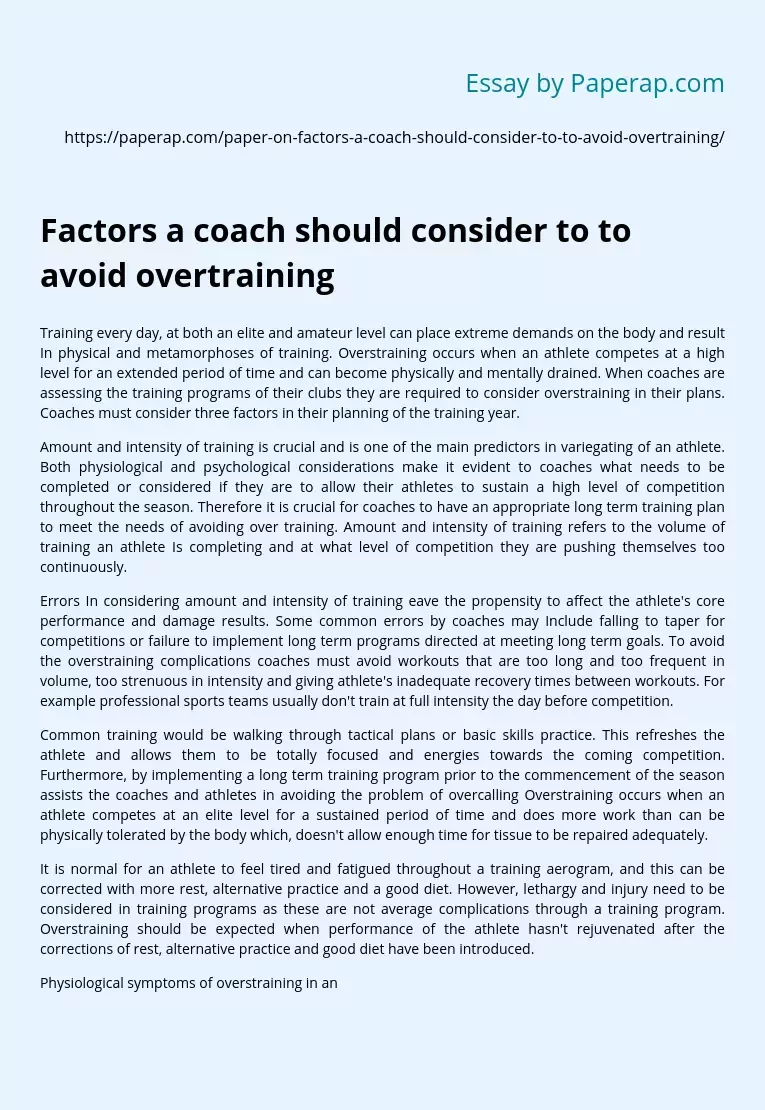Factors a coach should consider to to avoid overtraining
The following sample essay talks about the factors that a coach should consider in order to avoid overtraining. Read the introduction, body and conclusion of the essay, scroll down.
Training every day, at both an elite and amateur level can place extreme demands on the body and result In physical and metamorphoses of training. Overstraining occurs when an athlete competes at a high level for an extended period of time and can become physically and mentally drained. When coaches are assessing the training programs of their clubs they are required to consider overstraining in their plans.
Coaches must consider three factors in their planning of the training year.
Amount and intensity of training is crucial and is one of the main predictors in variegating of an athlete. Both physiological and psychological considerations make it evident to coaches what needs to be completed or considered if they are to allow their athletes to sustain a high level of competition throughout the season.
Therefore it is crucial for coaches to have an appropriate long term training plan to meet the needs of avoiding over training. Amount and intensity of training refers to the volume of training an athlete Is completing and at what level of competition they are pushing themselves too continuously.
Errors In considering amount and intensity of training eave the propensity to affect the athlete’s core performance and damage results. Some common errors by coaches may Include falling to taper for competitions or failure to implement long term programs directed at meeting long term goals.
To avoid the overstraining complications coaches must avoid workouts that are too long and too frequent in volume, too strenuous in intensity and giving athlete’s inadequate recovery times between workouts. For example professional sports teams usually don’t train at full intensity the day before competition.
Common training would be walking through tactical plans or basic skills practice. This refreshes the athlete and allows them to be totally focused and energies towards the coming competition. Furthermore, by implementing a long term training program prior to the commencement of the season assists the coaches and athletes in avoiding the problem of overcalling Overstraining occurs when an athlete competes at an elite level for a sustained period of time and does more work than can be physically tolerated by the body which, doesn’t allow enough time for tissue to be repaired adequately.
It is normal for an athlete to feel tired and fatigued throughout a training aerogram, and this can be corrected with more rest, alternative practice and a good diet. However, lethargy and injury need to be considered in training programs as these are not average complications through a training program. Overstraining should be expected when performance of the athlete hasn’t rejuvenated after the corrections of rest, alternative practice and good diet have been introduced.
Physiological symptoms of overstraining in an athlete include: Decline in physical performance, Injury (chronic and acute), increased resting and sub-maximal heart ate, Increased blood pressure, loss of weight and muscle tenderness. All of the symptoms listed above give a specific example of Incidents where overstraining can of occurred. It Is Important to understand that Just because an athlete has Increased blood pressure it doesn’t immediately implicate overstraining.
But when multiple common symptoms that occur at once and almost immediately resemble overstraining are decreased Max VIA, decreased muscle glycogen and decreased appetite and libido. It is essential for coaches to assess their athletes through the season training programs and make alterations where necessary. Psychological problems can occur when extensive loss of motivation and interest occur in athletes. It is natural for an athlete to lose contingencies of motivation throughout a training session and program.
However when symptoms of mental fatiguing to appear overstraining must be assessed immediately. These symptoms can include: sleep disturbances, extended feelings of exhaustion, decreased motivation and commitment and feelings of overall chronic stress. Again, like physiological spots it is important to note that one of these occurring doesn’t automatically imply overstraining but multiple homonyms or in this case symptoms lasting for an extended period of time, overstraining should be questioned.
Training sessions can be altered by coaches to make them more interesting and enjoyable by using small sided games or variations of game and drills. Boredom is a common cause of overstraining in athletes. Three social implications of psychological overstraining are decreased self-esteem, negative change in dealing with others and social withdrawals. These imply that the athlete is struggling with the stress being placed on them through the training program and as result are chronically continuously emotionally unstable.
It is vital that coach’s address these issues immediately when they arrive to ensure athletes are regain the passion and motivation towards training and their team mates. Overstraining has the propensity to have a major effect on training programs for a season throughout the course of a season or competition. Amount of training and intensity of training is important in understanding how hard a coach can push an athlete before they go beyond a workload that can be tolerated by the mind and the body.
Physiological implications must be assessed when multiple symptoms of overstraining occur and appropriate alterations must be made to ensure overstraining is either avoided of corrected. Psychological overstraining can be avoided by using variations of drills to ensure boredom is avoided. However, other symptoms of overstraining mentally must be watched out for and programs must also be monitored and changed where necessary. Overall training programs must be planned to attempt at avoiding overstraining, but they must be altered through the season to correct the complications that arise.
Factors a coach should consider to to avoid overtraining. (2017, Nov 12). Retrieved from https://paperap.com/paper-on-factors-a-coach-should-consider-to-to-avoid-overtraining/

